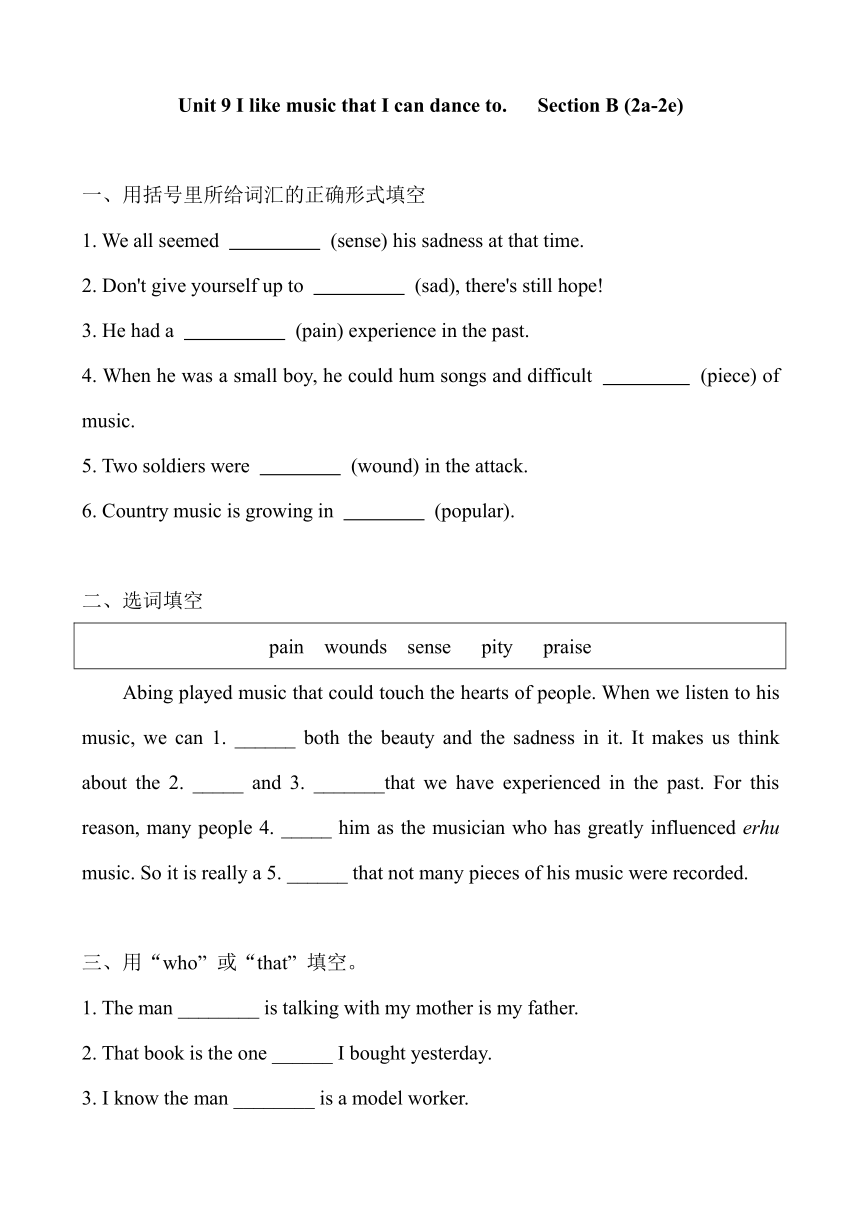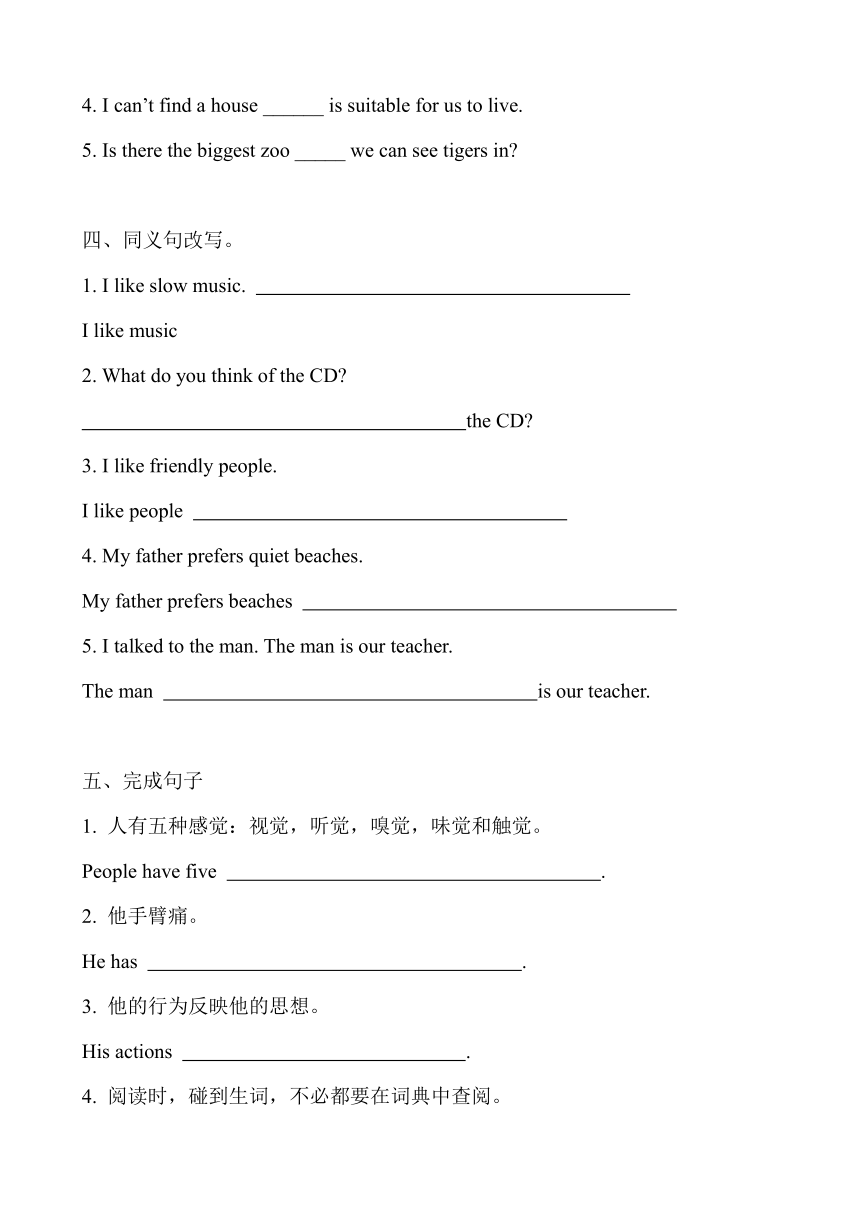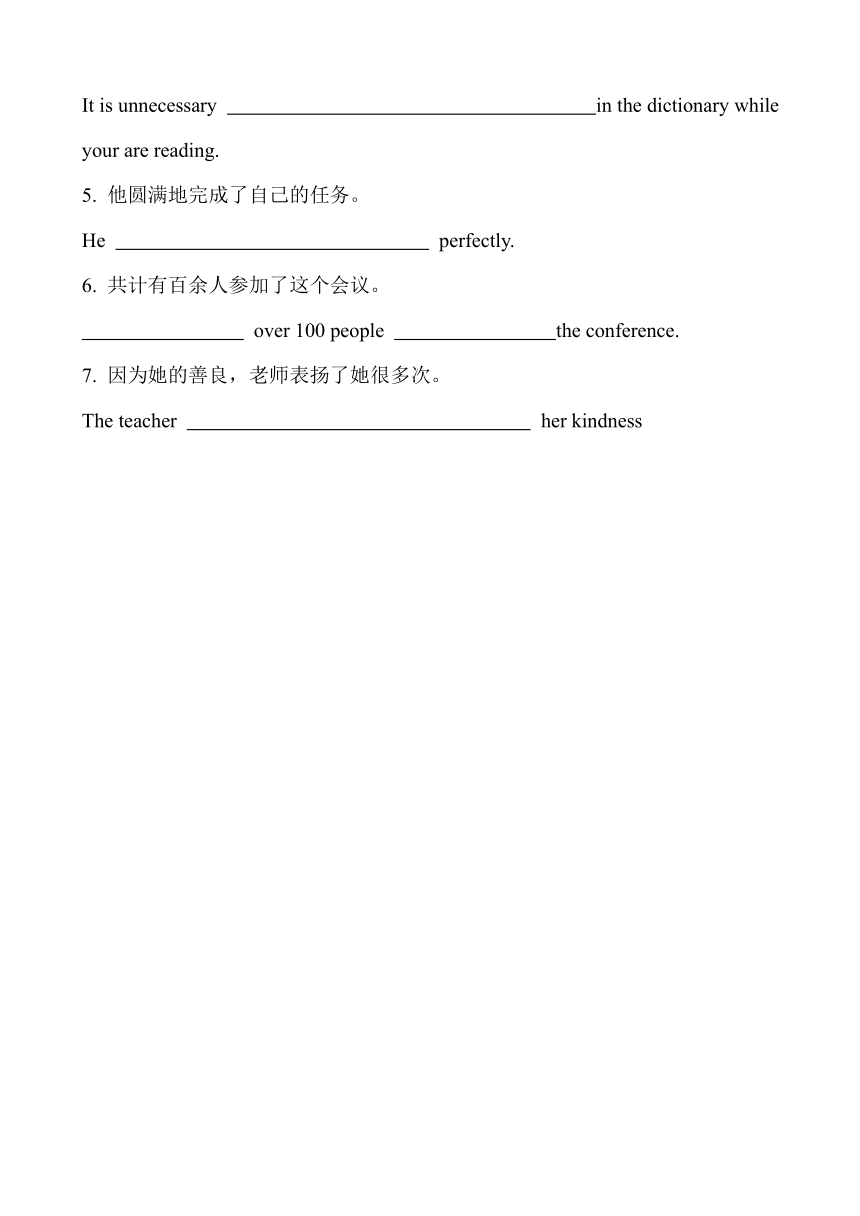Unit 9 I like music that I can dance to Section B 2a-2e 同步练习题(含答案)人教版英语九年级全册
文档属性
| 名称 | Unit 9 I like music that I can dance to Section B 2a-2e 同步练习题(含答案)人教版英语九年级全册 |  | |
| 格式 | docx | ||
| 文件大小 | 22.1KB | ||
| 资源类型 | 教案 | ||
| 版本资源 | 人教新目标(Go for it)版 | ||
| 科目 | 英语 | ||
| 更新时间 | 2025-02-24 13:01:41 | ||
图片预览



文档简介
Unit 9 I like music that I can dance to. Section B (2a-2e)
一、用括号里所给词汇的正确形式填空
1. We all seemed (sense) his sadness at that time.
2. Don't give yourself up to (sad), there's still hope!
3. He had a (pain) experience in the past.
4. When he was a small boy, he could hum songs and difficult (piece) of music.
5. Two soldiers were (wound) in the attack.
6. Country music is growing in (popular).
二、选词填空
pain wounds sense pity praise
Abing played music that could touch the hearts of people. When we listen to his music, we can 1. ______ both the beauty and the sadness in it. It makes us think about the 2. _____ and 3. _______that we have experienced in the past. For this reason, many people 4. _____ him as the musician who has greatly influenced erhu music. So it is really a 5. ______ that not many pieces of his music were recorded.
三、用“who” 或“that” 填空。
1. The man ________ is talking with my mother is my father.
2. That book is the one ______ I bought yesterday.
3. I know the man ________ is a model worker.
4. I can’t find a house ______ is suitable for us to live.
5. Is there the biggest zoo _____ we can see tigers in
四、同义句改写。
1. I like slow music.
I like music
2. What do you think of the CD
the CD
3. I like friendly people.
I like people
4. My father prefers quiet beaches.
My father prefers beaches
5. I talked to the man. The man is our teacher.
The man is our teacher.
五、完成句子
1. 人有五种感觉:视觉,听觉,嗅觉,味觉和触觉。
People have five .
2. 他手臂痛。
He has .
3. 他的行为反映他的思想。
His actions .
4. 阅读时,碰到生词,不必都要在词典中查阅。
It is unnecessary in the dictionary while your are reading.
5. 他圆满地完成了自己的任务。
He perfectly.
6. 共计有百余人参加了这个会议。
over 100 people the conference.
7. 因为她的善良,老师表扬了她很多次。
The teacher her kindness
### 一、用括号里所给词汇的正确形式填空
1. **to sense**:“seem to do sth.”是固定用法,表示“似乎做某事”,所以这里填“to sense”。
2. **sadness**:“give oneself up to sth.”表示“沉溺于某事”,“to”是介词,后面接名词,“sad”是形容词,其名词形式是“sadness”,所以填“sadness”。
3. **painful**:修饰名词“experience”要用形容词,“pain”是名词,其形容词是“painful”,表示“痛苦的”,所以填“painful”。
4. **pieces**:“piece”是可数名词,根据语境这里表示“很多首曲子”,要用复数形式“pieces”,所以填“pieces”。
5. **wounded**:“wound”作动词时表示“使受伤”,这里“soldiers”和“wound”之间是被动关系,要用被动语态,结构是“be + 过去分词”,“wound”的过去分词是“wounded”,所以填“wounded”。
6. **popularity**:“in”是介词,后面接名词,“popular”是形容词,其名词形式是“popularity”,表示“受欢迎,流行”,所以填“popularity”。
### 二、选词填空
1. **sense**:根据语境,当我们听阿炳的音乐时,我们能“感觉到”其中的美和悲伤,“sense”作动词时表示“感觉,感知”,所以填“sense”。
2. **pain**:结合前文提到音乐能触动人心,这里说让我们想起过去经历的“痛苦”,“pain”表示“痛苦”,所以填“pain”。
3. **wounds**:“wound”作名词时表示“创伤,伤口”,这里指过去经历的伤痛,要用复数形式“wounds”,所以填“wounds”。
4. **praise**:根据语境,很多人“赞扬”他是对二胡音乐有很大影响的音乐家,“praise”表示“赞扬,表扬”,所以填“praise”。
5. **pity**:“It is a pity that...”是固定句型,表示“很遗憾……”,所以填“pity”。
### 三、用“who” 或“that” 填空。
1. **who/that**:先行词是“the man”,指人,关系代词在定语从句中作主语,“who”和“that”都可以指人,在从句中作主语,所以可以填“who/that”。
2. **that**:先行词是“the one”(指代“book”),指物,当先行词是不定代词时,关系代词只能用“that”,所以填“that”。
3. **who/that**:先行词是“the man”,指人,关系代词在定语从句中作主语,“who”和“that”都可以指人,在从句中作主语,所以可以填“who/that”。
4. **that**:先行词是“a house”,指物,关系代词在定语从句中作主语,这里可以用“that”或“which”,但在“there be”句型中,一般用“that”,所以填“that”。
5. **that**:先行词是“the biggest zoo”,指物,当先行词被最高级修饰时,关系代词只能用“that”,所以填“that”。
### 四、同义句改写。
1. **that is slow**:原句“I like slow music.”可以用定语从句来改写,“music”是先行词,指物,关系代词用“that”,从句为“that is slow”,所以填“that is slow”。
2. **How do you like**:“What do you think of...”和“How do you like...”都表示“你认为……怎么样”,所以填“How do you like”。
3. **who are friendly**:原句“I like friendly people.”可以用定语从句改写,先行词是“people”,指人,关系代词用“who”,从句为“who are friendly”,所以填“who are friendly”。
4. **that are quiet**:原句“My father prefers quiet beaches.”可以用定语从句改写,先行词是“beaches”,指物,关系代词用“that”,从句为“that are quiet”,所以填“that are quiet”。
5. **whom I talked to**:原句合并为一个含有定语从句的句子,先行词是“the man”,指人,关系代词在从句中作宾语,“talk to sb.”,所以关系代词可以用“whom”,从句为“whom I talked to”,所以填“whom I talked to”。
### 五、完成句子
1. **senses: sight, hearing, smell, taste and touch**:“感觉”用“sense”,这里说五种感觉,要用复数形式“senses”,“视觉,听觉,嗅觉,味觉和触觉”分别是“sight, hearing, smell, taste and touch”,所以填“senses: sight, hearing, smell, taste and touch”。
2. **a pain in his arm**:“have a pain in + 身体部位”表示“某个部位疼痛”,所以填“a pain in his arm”。
3. **reflect his thoughts**:“反映”用“reflect”,“思想”用“thought”,这里用复数形式“thoughts”,所以填“reflect his thoughts”。
4. **to look up all the new words**:“It is + 形容词 + to do sth.”是固定句型,“查阅”用“look up”,“生词”是“new words”,所以填“to look up all the new words”。
5. **completed his task**:“完成任务”用“complete one's task”,根据语境这里用一般过去时,“complete”的过去式是“completed”,所以填“completed his task”。
6. **In total; took part in**:“共计”用“in total”,句首单词首字母大写;“参加”用“take part in”,根据语境用一般过去时,“take”的过去式是“took”,所以填“In total; took part in”。
7. **praised her many times because of**:“表扬某人”用“praise sb.”,根据语境用一般过去时,“praise”的过去式是“praised”,“很多次”是“many times”,“因为”用“because of”,后面接名词短语,所以填“praised her many times because of”。
一、用括号里所给词汇的正确形式填空
1. We all seemed (sense) his sadness at that time.
2. Don't give yourself up to (sad), there's still hope!
3. He had a (pain) experience in the past.
4. When he was a small boy, he could hum songs and difficult (piece) of music.
5. Two soldiers were (wound) in the attack.
6. Country music is growing in (popular).
二、选词填空
pain wounds sense pity praise
Abing played music that could touch the hearts of people. When we listen to his music, we can 1. ______ both the beauty and the sadness in it. It makes us think about the 2. _____ and 3. _______that we have experienced in the past. For this reason, many people 4. _____ him as the musician who has greatly influenced erhu music. So it is really a 5. ______ that not many pieces of his music were recorded.
三、用“who” 或“that” 填空。
1. The man ________ is talking with my mother is my father.
2. That book is the one ______ I bought yesterday.
3. I know the man ________ is a model worker.
4. I can’t find a house ______ is suitable for us to live.
5. Is there the biggest zoo _____ we can see tigers in
四、同义句改写。
1. I like slow music.
I like music
2. What do you think of the CD
the CD
3. I like friendly people.
I like people
4. My father prefers quiet beaches.
My father prefers beaches
5. I talked to the man. The man is our teacher.
The man is our teacher.
五、完成句子
1. 人有五种感觉:视觉,听觉,嗅觉,味觉和触觉。
People have five .
2. 他手臂痛。
He has .
3. 他的行为反映他的思想。
His actions .
4. 阅读时,碰到生词,不必都要在词典中查阅。
It is unnecessary in the dictionary while your are reading.
5. 他圆满地完成了自己的任务。
He perfectly.
6. 共计有百余人参加了这个会议。
over 100 people the conference.
7. 因为她的善良,老师表扬了她很多次。
The teacher her kindness
### 一、用括号里所给词汇的正确形式填空
1. **to sense**:“seem to do sth.”是固定用法,表示“似乎做某事”,所以这里填“to sense”。
2. **sadness**:“give oneself up to sth.”表示“沉溺于某事”,“to”是介词,后面接名词,“sad”是形容词,其名词形式是“sadness”,所以填“sadness”。
3. **painful**:修饰名词“experience”要用形容词,“pain”是名词,其形容词是“painful”,表示“痛苦的”,所以填“painful”。
4. **pieces**:“piece”是可数名词,根据语境这里表示“很多首曲子”,要用复数形式“pieces”,所以填“pieces”。
5. **wounded**:“wound”作动词时表示“使受伤”,这里“soldiers”和“wound”之间是被动关系,要用被动语态,结构是“be + 过去分词”,“wound”的过去分词是“wounded”,所以填“wounded”。
6. **popularity**:“in”是介词,后面接名词,“popular”是形容词,其名词形式是“popularity”,表示“受欢迎,流行”,所以填“popularity”。
### 二、选词填空
1. **sense**:根据语境,当我们听阿炳的音乐时,我们能“感觉到”其中的美和悲伤,“sense”作动词时表示“感觉,感知”,所以填“sense”。
2. **pain**:结合前文提到音乐能触动人心,这里说让我们想起过去经历的“痛苦”,“pain”表示“痛苦”,所以填“pain”。
3. **wounds**:“wound”作名词时表示“创伤,伤口”,这里指过去经历的伤痛,要用复数形式“wounds”,所以填“wounds”。
4. **praise**:根据语境,很多人“赞扬”他是对二胡音乐有很大影响的音乐家,“praise”表示“赞扬,表扬”,所以填“praise”。
5. **pity**:“It is a pity that...”是固定句型,表示“很遗憾……”,所以填“pity”。
### 三、用“who” 或“that” 填空。
1. **who/that**:先行词是“the man”,指人,关系代词在定语从句中作主语,“who”和“that”都可以指人,在从句中作主语,所以可以填“who/that”。
2. **that**:先行词是“the one”(指代“book”),指物,当先行词是不定代词时,关系代词只能用“that”,所以填“that”。
3. **who/that**:先行词是“the man”,指人,关系代词在定语从句中作主语,“who”和“that”都可以指人,在从句中作主语,所以可以填“who/that”。
4. **that**:先行词是“a house”,指物,关系代词在定语从句中作主语,这里可以用“that”或“which”,但在“there be”句型中,一般用“that”,所以填“that”。
5. **that**:先行词是“the biggest zoo”,指物,当先行词被最高级修饰时,关系代词只能用“that”,所以填“that”。
### 四、同义句改写。
1. **that is slow**:原句“I like slow music.”可以用定语从句来改写,“music”是先行词,指物,关系代词用“that”,从句为“that is slow”,所以填“that is slow”。
2. **How do you like**:“What do you think of...”和“How do you like...”都表示“你认为……怎么样”,所以填“How do you like”。
3. **who are friendly**:原句“I like friendly people.”可以用定语从句改写,先行词是“people”,指人,关系代词用“who”,从句为“who are friendly”,所以填“who are friendly”。
4. **that are quiet**:原句“My father prefers quiet beaches.”可以用定语从句改写,先行词是“beaches”,指物,关系代词用“that”,从句为“that are quiet”,所以填“that are quiet”。
5. **whom I talked to**:原句合并为一个含有定语从句的句子,先行词是“the man”,指人,关系代词在从句中作宾语,“talk to sb.”,所以关系代词可以用“whom”,从句为“whom I talked to”,所以填“whom I talked to”。
### 五、完成句子
1. **senses: sight, hearing, smell, taste and touch**:“感觉”用“sense”,这里说五种感觉,要用复数形式“senses”,“视觉,听觉,嗅觉,味觉和触觉”分别是“sight, hearing, smell, taste and touch”,所以填“senses: sight, hearing, smell, taste and touch”。
2. **a pain in his arm**:“have a pain in + 身体部位”表示“某个部位疼痛”,所以填“a pain in his arm”。
3. **reflect his thoughts**:“反映”用“reflect”,“思想”用“thought”,这里用复数形式“thoughts”,所以填“reflect his thoughts”。
4. **to look up all the new words**:“It is + 形容词 + to do sth.”是固定句型,“查阅”用“look up”,“生词”是“new words”,所以填“to look up all the new words”。
5. **completed his task**:“完成任务”用“complete one's task”,根据语境这里用一般过去时,“complete”的过去式是“completed”,所以填“completed his task”。
6. **In total; took part in**:“共计”用“in total”,句首单词首字母大写;“参加”用“take part in”,根据语境用一般过去时,“take”的过去式是“took”,所以填“In total; took part in”。
7. **praised her many times because of**:“表扬某人”用“praise sb.”,根据语境用一般过去时,“praise”的过去式是“praised”,“很多次”是“many times”,“因为”用“because of”,后面接名词短语,所以填“praised her many times because of”。
同课章节目录
- Unit 1 How can we become good learners.
- Section A
- Section B
- Unit 2 I think that mooncakes are delicious!
- Section A
- Section B
- Unit 3 Could you please tell me where the restroom
- Section A
- Section B
- Unit 4 I used to be afraid of the dark.
- Section A
- Section B
- Unit 5 What are the shirts made of?
- Section A
- Section B
- Review of Units 1-5
- Unit 6 When was it invented?
- Section A
- Section B
- Unit 7 Teenagers should be allowed to choose their
- Section A
- Section B
- Unit 8 It must belong to Carla.
- Section A
- Section B
- Unit 9 I like music that I can dance to.
- Section A
- Section B
- Unit 10 You're supposed to shake hands.
- Section A
- Section B
- Review of Units 6-10
- Unit 11 Sad movies make me cry.
- Section A
- Section B
- Unit 12 Life is full of the unexpected
- Section A
- Section B
- Unit 13 We're trying to save the earth!
- Section A
- Section B
- Unit 14 I remember meeting all of you in Grade 7.
- Section A
- Section B
- Review of Units 11-14
